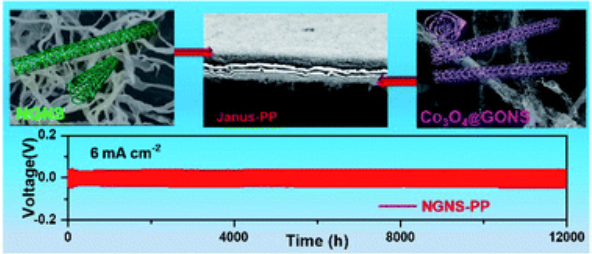Z.G. Zhang, Y.F. Dong, Y.F. Gu, P.F. Lu, F.F. Xue, Y.T. Fan, Z.C. Zhu, J. Lin, Q.H. Li* and Z.-S. Wu;
Journal of Materials Chemistry A, 2022, Advance Article.
DOI: 10.1039/D2TA01515C [PDF]

Li sulfur (Li–S) battery is regarded as one of the most promising candidates for next-generation rechargeable batteries. However, some challenging obstacles such as uncontrolled dendrites of Li metal anode and polysulfides shuttling in the sulfur cathode substantially impede the practical application. In this work, we propose a versatile strategy of fabricating graphene nanoscroll (GNS) based bifunctional Janus polypropylene (Janus PP) separators for inhibiting lithium dendrites and suppressing polysulfides shuttling toward high-performance Li–S batteries. On the anode side of the separator, nitrogen-doped GNS (NGNS) were used to protect the lithium metal. The highly uniform NGNS nanostructure facilitated electrolyte penetration and homogenous Li+flux, thus fundamentally prompting lithiation/delithiation kinetics and inhibiting the growth of Li dendrites. Due to these properties, the Li symmetrical cell with NGNS-modified PP separator (NGNS-PP) delivers an ultralow voltage hysteresis of 36 mV at 6.0 mA cm−2after 12 000 h (65.5 mV at 10 mA cm−2after 3400 h). On the cathode side, GNS-wrapped Co3O4nanoparticles (Co3O4@GNS) used as an interlayer on the PP separator, acting as a wonderful physical blocking and chemical catalytic layer to sufficiently mitigate the “shuttle effects” of lithium polysulfides. As a result, with the Janus PP separator, Li–S cells obtained a stable capacity of 805 mA h g−1after 800 cycles (a capacity decay of 0.018% per cycle at 1.0C). Therefore, this proposed strategy of GNS-based Janus separators will pave a new way to rationally construct durable and efficient Li–S batteries.